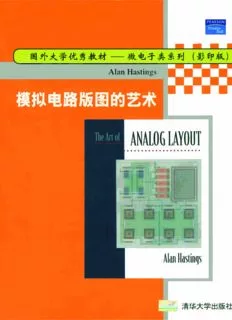
The Art of Analog Layout PDF
Preview The Art of Analog Layout
I The Art of Analog Layout Alan Hastings English reprint editior,copyright 2004byPEARSONEDUCATIONASLALIMITEDandTSINGHUAUNIVERSITY PRESS. Original English language titlefromProprietor's edition oftheWork. Original English language title: TheArtofAnalog Layout, by Alan Hastings,Copyright 2001 All Rights Reserved. Publishedbyarrangementwiththe original publisher, PearsonEducation,Inc.,publishingasPrenticeHall, Inc. Thiseditionisauthorizedforsaleanddistribution only inthePeople's Republic of China (excluding the Special Administrative RegionofHongKong,Macao SAR andTaiwan). PearsonEducation, For sale and distributionin the People's Republic of China exclusively (except Taiwan, Hong KongSAR and Macao SAR). 01-2004-1393 PearsonEducation =TheArtofAnalog Layout 2004 ISBN7-302-08226-X CIP (2004) 017361 8: http:Nwww.tup.com.cn (010)6277 0175 203x260 35.25 ISBN 177 EP 1-3000 72.00 Contents Preface xvii Acknowledgments 1 Device Physics 1.1 Semiconductors 1 1.1.1 Generationand Recombination 4 1.1.2 Extrinsic Semiconductors 6 1.1.3 Diffusion and Drift 9 1.2 PNJunctions 10 1.2.1 Depletion Regions 10 1.2.2 PNDiodes 13 1.2.3 Schottky Diodes 15 1.2.4 ZenerDiodes 17 1.2.5 OhmicContacts 19 1.3 Bipolar Junction Transistors 20 1.3.1 Beta 22 1.3.2 I-VCharacteristics 23 1.4 MOSTransistors 24 1.4.1 ThresholdVoltage 27 1.4.2 I-VCharacteristics 29 1.5 JFETTransistors 31 1.6 Summary 33 1.7 Exercises 34 2 Semiconductor Fabrication 2.1 Silicon Manufacture 36 2.1.1 Crystal Growth 37 2.1.2 WaferManufacturing 38 2.1.3 The CrystalStructureofSilicon 38 2.2 Photolithography 40 2.2.1 Photoresists 40 2.2.2 Photomasks and Reticles 41 2.2.3 Patterning 42 2.3 Oxide Growth and Removal 42 2.3.1 OxideGrowthandDeposition 43 2.3.2 OxideRemoval 44 2.3.3 OtherEffectsof OxideGrowthand Removal 46 2.3.4 LocalOxidationofSilicon(LOCOS) 48 vii viii CONTENTS 2.4 Diffusion andIonImplantation 49 2.4.1 Diffusion 50 2.4.2 OtherEffects of Diffusion 52 2.4.3 Ion Implantation 53 2.5 Silicon Deposition 55 2.5.1 Epitaxy 56 2.5.2 PolysiliconDeposition 58 2.6 Metallization 58 2.6.1 Deposition andRemovalofAluminum 59 2.6.2 RefractoryBarrierMetal 60 2.6.3 Silicidation 62 2.6.4 Interlevel Oxide, InterlevelNitride,andProtectiveOvercoat 63 2.7 Assembly 64 2.7.1 MountandBond 66 2.7.2 Packaging 69 2.8 Summary 69 2.9 Exercises 69 3 Representative Processes 3.1 StandardBipolar 72 3.1.1 EssentialFeatures 72 3.1.2 FabricationSequence 73 Starting Material 73 N-Buried Layer 73 EpitaxialGrowth 74 IsolationDiffusion 74 Deep-N+ 74 BaseImplant 75 Emitter Diffusion 75 Contact 76 Metallization 76 ProtectiveOvercoat 77 3.1.3 AvailableDevices 77 NPNTransistors 77 PNPTransistors 79 Resistors 81 Capacitors 83 3.1.4 ProcessExtensions 84 Up-down Isolation 84 Double-level Metal 84 Schottky Diodes 85 High-Sheet Resistors 86 Super-beta Transistors 86 3.2 Polysilicon-GateCMOS 87 3.2.1 Essential Features 88 CONTENTS ix 3.2.2 FabricationSequence 89 StartingMaterial 89 EpitaxialGrowth 89 N-well Diffusion 89 Inverse Moat 90 Channel Stop Implants 90 LOCOS Processing and DummyGate Oxidation 91 Threshold Adjust 92 Polysilicon Deposition and Patterning 93 Source/Drain Implants 93 Contacts 94 Metallization 94 Protective Overcoat 94 3.2.3 AvailableDevices 95 NMOSTransistors 95 PMOSTransistors 97 SubstratePNPTransistors 98 Resistors 98 Capacitors 100 3.2.4 ProcessExtensions 100 Double-level Metal 100 Silicidation 101 Lightly Doped Drain (LDD)Transistors 101 Extended-Drain, High-Voltage Transistors 103 3.3 Analog BiCMOS 104 3.3.1 EssentialFeatures 104 3.3.2 FabricationSequence 106 StartingMaterial 106 N-buried Layer 106 EpitaxialGrowth 106 N-wellDiffusionand Deep-N+ 107 BaseImplant 107 InverseMoat 108 ChannelStop Implants 108 LOCOS Processing and DummyGateOxidation 108 Threshold Adjust 109 Polysilicon Deposition and Pattern 109 Source/DrainImplants 109 Metallization and Protective Overcoat 110 ProcessComparison 110 3.3.3 AvailableDevices 111 NPNTransistors 112 PNPTransistors 112 Resistors 115 3.4 Summary 115 3.5 Exercises 116 x CONTENTS Failure Mechanisms 4.1 ElectricalOverstress 118 4.1.1 Electrostatic Discharge (ESD) 118 Effects 120 Preventative Measures 120 4.1.2 Electromigration 121 Effects 121 PreventativeMeasures 122 4.1.3 The Antenna Effect 122 4.2 Contamination 124 4.2.1 Dry Corrosion 124 Effects 124 PreventativeMeasures 125 4.2.2 MobileIonContamination 125 Effects 125 Preventative Measures 126 4.3 SurfaceEffects 128 4.3.1 Hot CarrierInjection 128 Effects 128 PreventativeMeasures 130 4.3.2 ParasiticChannelsandChargeSpreading 131 Effects 131 PreventativeMeasures(Standard Bipolar) 133 PreventativeMeasures(CMOSand BiCMOS) 137 4.4 Parasitics 139 4.4.1 SubstrateDebiasing 140 Eflects 140 PreventativeMeasures 142 4.4.2 Minority-CarrierInjection 143 Effects 143 PreventativeMeasures(Substrate Injection) 146 PreventativeMeasures(Cross-injection) 151 4.5 Summary 153 4.6 Exercises 153 5 Resistors 5.1 ResistivityandSheet Resistance 156 5.2 Resistor Layout 158 5.3 ResistorVariability 162 5.3.1 ProcessVariation 162 5.3.2 Temperature Variation 163 5.3.3 Nonlinearity 163 5.3.4 ContactResistance 166 5.4 ResistorParasitics 167 CONTENTS 5.5 Comparisonof AvailableResistors 170 5.5.1 Base Resistors 170 5.5.2 Emitter Resistors 171 5.5.3 Base Pinch Resistors 172 5.5.4 High-Sheet Resistors 173 5.5.5 EpiPinch Resistors 175 5.5.6 Metal Resistors 176 5.5.7 PolyResistors 177 5.5.8 NSDandPSD Resistors 180 5.5.9 N-wellResistors 180 5.5.10 Thin-film Resistors 181 5.6 Adjusting Resistor Values 182 5.6.1 TweakingResistors 182 SlidingContacts 183 Sliding Heads 184 Trombone Slides 184 MetalOptions 184 5.6.2 TrimmingResistors 185 Fuses 185 ZenerZaps 189 LaserTrims 190 5.7 Summary 191 5.8 Exercises 192 6 Capacitors 6.1 Capacitance 194 6.2 CapacitorVariability 200 6.2.1 Process Variation 200 6.2.2 VoltageModulation and Temperature Variation 201 6.3 Capacitor Parasitics 203 6.4 Comparisonof Available Capacitors 205 6.4.1 Base-emitter Junction Capacitors 205 6.4.2 MOSCapacitors 207 6.4.3 Poly-polyCapacitors 209 6.4.4 Miscellaneous Styles of Capacitors 211 6.5 Summary 212 6.6 Exercises 212 7 Matching of Resistors and Capacitors 7.1 MeasuringMismatch 214 7.2 Causesof Mismatch 217 7.2.1 RandomStatisticalFluctuations 217 7.2.2 Process Biases 219 7.2.3 PatternShift 220
